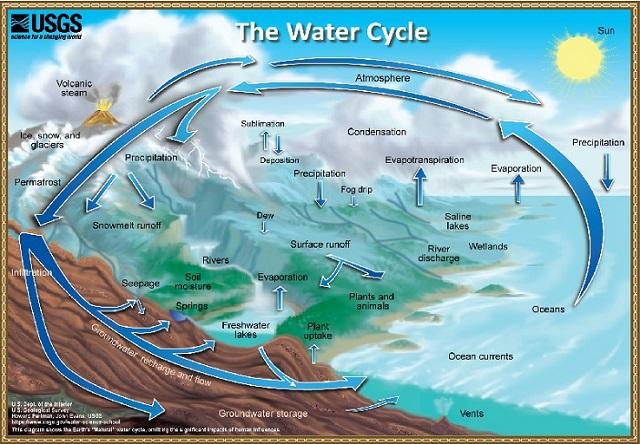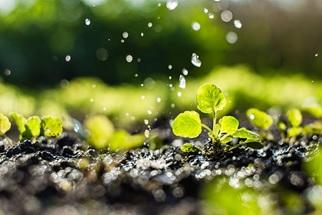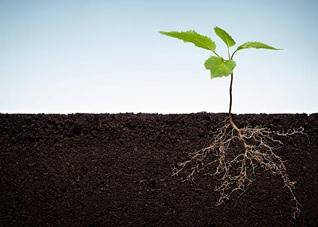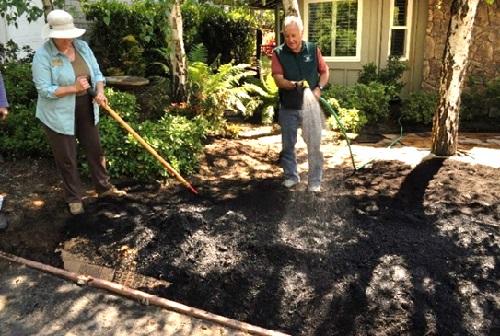
Water in the Landscape
Earth's water is always in motion. The natural water cycle, also known as the hydrologic cycle, describes the continuous movement of water on, above, and below the surface of the Earth.
Correct awareness of our consumption and use of water are the key factors that affect water use behavior. Many people have misconceptions about water consumption which leads to its waste in households and landscapes.

Water Management in the Landscape
We can efficiently provide water to our plants in ways that allow us to have a beautiful garden and landscape while minimizing our use of water. Managing water use for plants changes throughout the year. Here are some specific recommendations for how to manage water in your landscape.

- Plant Choice
- Choose climate-appropriate plants. Select low- and very-low water-use plants that suit our summer-dry climate. Recommended Plants for Sonoma County
- Convert your lawn to low-water-use plants or allow your lawn to go brown and dormant in the summer.
- Optimizing the Irrigation System
- Use drip irrigation instead of sprinklers and other methods such as soaker hoses, micro-sprayers, or bubblers. Drip systems are the most efficient.
- Switch to rotary nozzles in sprinkler heads if you want to keep some lawn.
- Plant in hydrozones by grouping together plants that have the same irrigation requirements on the same irrigation line.
- Maintain your irrigation system regularly by:
- checking at least monthly for leaks and clogged emitters;
- flushing irrigation lines and cleaning filters seasonally or monthly;
- making sure your irrigation controller and hose bib timers are working properly;
- having fresh batteries at the beginning of the irrigation season (in March).
- Reserve hand watering only for those plants that need extra water, being mindful of potential runoff. Be as efficient as possible.
- Incorporate rainwater, graywater, and recycled water into your landscape and watering methods when appropriate. See “Water Conservation Recommendations”
- Schedule Irrigation to Suit Plant Requirements
- Apply the right amount of water at the right time by maintaining suitable irrigation schedules.
- Water requirements of plants change throughout the year. Plants need the most water during the summer, less during early spring, late fall, and winter. Native plants require water in dry winters.
- Adjust your irrigation schedule on a monthly or even daily basis. There are a number of ways to do this.
- Choose Smart irrigation controllers that automatically adjust to weather conditions (with weather sensor hookup or remote weather station) throughout the irrigation season. A rain sensor can also be added.
- Use the “water budgeting” feature on older or simpler irrigation controllers that allow programming by decreasing watering time during June and August—that is, by making seasonal adjustments before and after the month with the highest-water-requirements (July). Lacking a water budgeting feature, program seasonal adjustments manually on a monthly basis. A rain sensor can also be added.
- Manually adjust hose-bib timers monthly using seasonal adjustments.
- Make use of Sonoma Water and the City of Santa Rosa online irrigation timing tools.
Water Conservation Recommendations
Plants absorb soil moisture and essential elements through their roots. This triggers a nutrient flow through stems to the leaves where water is transpired back into the atmosphere. Thus, water storage in the soil is best replenished by irrigation at the plant root zone. Irrigation should be done during periods when plants need the most water; in Sonoma County this is typically during summers and during a dry winter.

In the home landscape, there are many ways to conserve water and ensure important water savings. Here are some ways we recommend:
- Irrigate efficiently using drip irrigation.
- Apply mulch.
- Be water smart when designing a garden and choosing plants.
- Incorporate rain gardens into the landscape.
- Use alternative water sources.
- Use these tools to decrease irrigation and timing when maintaining a lawn.
- Find more information on how to conserve and protect water in the landscape.
Drip Irrigation - Best Practices
Efficient watering means putting the right amount of water in the right place when plants need it without excess runoff, over-spray, or waste. Sprinkler systems and hand watering are only 50-70 percent efficient. Drip irrigation exceeds 90 percent efficiency because water drips into the ground slowly from plastic tubing through special outlets called emitters and moves directly to the root zone.
Consult the detailed information on Drip Irrigation for installing a new system or converting an existing irrigation system in your home landscape.
Lawn Conversion
Lawns require regular irrigation in our summer-dry climate and consequently have become one of the largest users of water in a home landscape. Coupled with our repeated droughts, this heavy dependency on irrigation has motivated many homeowners to save water and money by replacing turfgrass with alternative lower water-use plants. If you have a lawn that isn’t being used, consider replacing it with a more water-efficient and sustainable option.

Irrigation Conversion for Lawn Removal
Before beginning to remove a lawn, factor in the irrigation conversion process from spray to drip irrigation, a water-smart way to effectively water a garden. For more information on irrigation conversion, consult:
Sod Removal Methods
There are several ways to embark on a lawn removal project. The UC Master Gardener Program of Sonoma County recommends the sheet mulching method.
- Sheet Mulching.
- Generates a healthy, productive, and low-maintenance ecosystem.
- Improves nutrient and water retention of the soil.
- Suppresses weed growth without chemicals.
- Uses free or inexpensive sheets of recycled cardboard or thick sections of newspaper to begin the smothering process.
- Adds compost and mulch to encourage favorable microbial activity as the grass decomposes in place.
- Enhances soil structure to improve drainage and reduce soil erosion.
- Allows planting immediately.
- To learn more about the sheet mulching process and county resources, consult: Do-It-Yourself Lawn Removal
- To learn more about microbial activity, consult: Enriching Garden Soil
- Sod Cutting
Pros:- Strips of turf can be cut, turned upside down, and piled together to create the basis for a raised bed or berm.
- Sod-cutting is labor intensive and may require hiring a landscape professional.
- Equipment is expensive to rent and difficult to handle.
- Strips of cut sod require a truck for hauling to a disposal site or landfill where dumping fees are charged.
- Sod-cutting machine cannot be used on a lawn where tree roots have emerged.
- Sod removal will not stop persistent perennial grasses and weeds such as Bermuda grass from re-growing.
- Solarization Given the right conditions solarization can kill grass and weeds.
Pros:- Uses the sun’s energy and plastic sheeting to kill the grass/weeds.
- Must be done in an area with high summer temperatures and 6-8 hours of full sun.
- Foot or animal traffic cannot occur in area being treated.
- Plastic sheeting must be kept airtight over treated area.
- All soil life in the top 12-18 inches is killed by intense heat.
- Additional Resources:
July 2023







